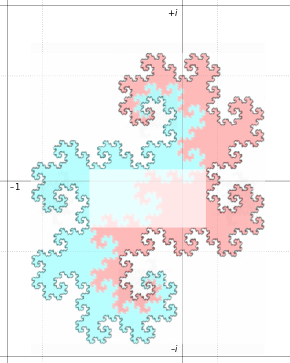Complex-base system
| Numeral systems |
|---|
 |
| Hindu–Arabic numeral system |
| East Asian |
| Alphabetic |
| Former |
| Positional systems by base |
| Non-standard positional numeral systems |
| List of numeral systems |
In arithmetic, a complex-base system is a positional numeral system whose radix is an imaginary (proposed by Donald Knuth in 1955[1][2]) or complex number (proposed by S. Khmelnik in 1964[3] and Walter F. Penney in 1965[4][5][6]).
In general
Let be an integral domain , and the (Archimedean) absolute value on it.
A number in a positional number system is represented as an expansion
where
is the radix (or base) with , is the exponent (position or place) , are digits from the finite set of digits , usually with
The cardinality is called the level of decomposition.
A positional number system or coding system is a pair
with radix and set of digits , and we write the standard set of digits with digits as
Desirable are coding systems with the features:
- Every number in , e. g. the integers , the Gaussian integers or the integers , is uniquely representable as a finite code, possibly with a sign ±.
- Every number in the field of fractions , which possibly is completed for the metric given by yielding or , is representable as an infinite series which converges under for , and the measure of the set of numbers with more than one representation is 0. The latter requires that the set be minimal, i. e. for real resp. for complex numbers.
In the real numbers
In this notation our standard decimal coding scheme is denoted by
the standard binary system is
the negabinary system is
and the balanced ternary system[2] is
All these coding systems have the mentioned features for and , and the last two do not require a sign.
In the complex numbers
Well-known positional number systems for the complex numbers include the following ( being the imaginary unit):
- , e. g. [1] and
- ,[2] the quater-imaginary base, proposed by Donald Knuth in 1955.
- and
- , where , and is a positive integer that can take multiple values at a given .[7] For and this is the system
- .[8]
- , where the set consists of complex numbers , and numbers , e. g.
- , where [9]
Binary systems
Binary coding systems of complex numbers, i. e. systems with the digits , are of practical interest.[9] Listed below are some coding systems (all are special cases of the systems above) and codes for the numbers −1, 2, −2, i. The standard binary (which requires a sign) and the "negabinary" systems are also listed for comparison. They do not have a genuine expansion for i.
| Radix | –1 ← | 2 ← | –2 ← | i ← | Twins and triplets |
|---|---|---|---|---|---|
| 2 | –1 | 10 | –10 | i | 1 ← 0.1 = 1.0 |
| –2 | 11 | 110 | 10 | i | 1⁄3 ← 0.01 = 1.10 |
| i√2 | 101 | 10100 | 100 | 10.101010100…[11] | 1⁄3+1⁄3i√2 ← 0.0011 = 11.1100 |
| –1+i | 11101 | 1100 | 11100 | 11 | 1⁄5+3⁄5i ← 0.010 = 11.001 = 1110.100 |
| (–1+i√7) ⁄2 | 111 | 1010 | 110 | 11.110001100…[11] | (3+i√7) ⁄4 ← 1.011 = 11.101 = 11100.110 |
| ρ2 | 101 | 10100 | 100 | 10 | 1⁄3+1⁄3i ← 0.0011 = 11.1100 |
| 2i | 103 | 2 | 102 | 10.2 | 1⁄5+2⁄5i ← 0.0033 = 1.3003 = 10.0330 = 11.3300 |
As in all positional number systems with an Archimedean absolute value, there are some numbers with multiple representations. Examples of such numbers are shown in the right column of the table. All of them are repeating fractions with the repetend marked by a horizontal line above it.
If the set of digits is minimal, the set of such numbers has a measure of 0. This is the case with all the mentioned coding systems.
The almost binary quater-imaginary system is shown in the bottom line for comparison purposes.
Base −1 ± i

Of particular interest are the quater-imaginary base (base 2 i) and the base −1 ± i systems discussed below, both of which can be used to finitely represent the Gaussian integers without sign.
Base −1 ± i, using digits 0 and 1, was proposed by S. Khmelnik in 1964[3] and Walter F. Penney in 1965.[4][6] The rounding region of an integer – i.e., a set of complex (non-integer) numbers that share the integer part of their representation in this system – has a fractal shape: the twindragon (see figure). This set is, by definition, all points that can be written as with . The rectangle in the center intersects the coordinate axes counterclockwise at the following points: , , and , and . can be decomposed into 16 pieces congruent to . Notice that if is rotated counterclockwise by 135°, we obtain two adjacent sets congruent to , because . Most importantly, contains all complex numbers that are of sufficiently small magnitude.[12] Thus, there is an injection of the complex rectangle into the interval of real numbers by mapping (hereby base cannot be taken because of ).
See also
References
- 1 2 Knuth, D.E. (1960). "An Imaginary Number System". Communication of the ACM-3 (4).
- 1 2 3 Knuth, Donald (1998). "Positional Number Systems". The art of computer programming. Volume 2 (3rd ed.). Boston: Addison-Wesley. p. 205. ISBN 0-201-89684-2. OCLC 48246681.
- 1 2 3 Khmelnik, S.I. (1964). "Specialized digital computer for operations with complex numbers". Questions of Radio Electronics (in Russian). XII (2).
- 1 2 W. Penney, A "binary" system for complex numbers, JACM 12 (1965) 247-248.
- 1 2 Jamil, T. (2002). "The complex binary number system". IEEE Potentials. 20 (5): 39–41. doi:10.1109/45.983342.
- 1 2 Duda, Jarek (2008-02-24). "Complex base numeral systems". arXiv:0712.1309
 [math.DS].
[math.DS]. - ↑ Khmelnik, S.I. (1966). "Positional coding of complex numbers". Questions of Radio Electronics (in Russian). XII (9).
- 1 2 Khmelnik, S.I. (2004 (see also here)). Coding of Complex Numbers and Vectors (in Russian). «Mathematics in Computers», Israel, ISBN 978-0-557-74692-7. Check date values in:
|date=(help) - 1 2 Khmelnik, S.I. (2001). Method and system for processing complex numbers. Patent USA, US2003154226 (A1).
- ↑ William J. Gilbert, “Arithmetic in Complex Bases” Mathematics Magazine Vol. 57, No. 2, March 1984
- 1 2 infinite non-repeating sequence
- ↑ Knuth 1998 p.206
External links
- "Number Systems Using a Complex Base" by Jarek Duda, the Wolfram Demonstrations Project
- "The Boundary of Periodic Iterated Function Systems" by Jarek Duda, the Wolfram Demonstrations Project
- "Number Systems in 3D" by Jarek Duda, the Wolfram Demonstrations Project